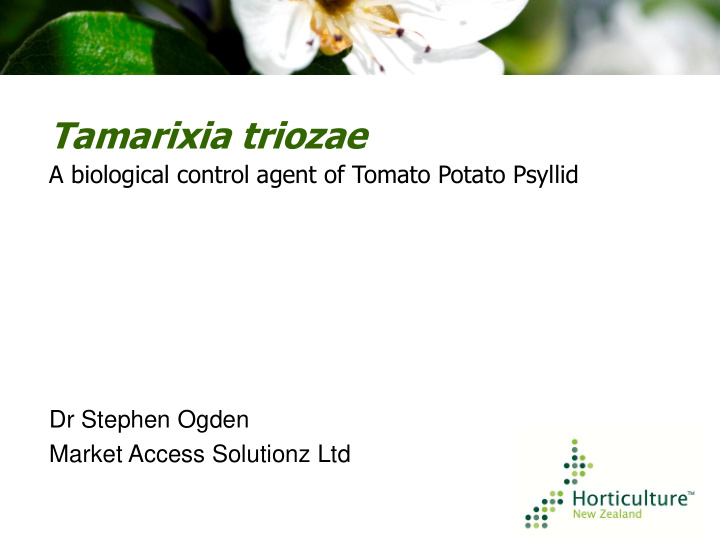



Tamarixia triozae A biological control agent of Tomato Potato Psyllid Dr Stephen Ogden Market Access Solutionz Ltd
Application to release Tamarixia triozae Why we are applying to release T. triozae TPP – the problem Researching the solutions Why is Tamarixia needed? How will Tamarixia be used? Industry group perspectives Response to submissions Technical experts
TPP – the problem TPP – Bactericera cockerelli Detected in 2006 in a tomato greenhouse Yellowing and curling of leaves Psyllid yellows Found to be widespread – not eradicated TPP known to cause “Zebra chip” in potatoes in USA – but not why
Tomato Potato Psyllid (TPP) - Laid on stalks, leaf margins - 7 days to hatch J Clark, Univ. Calif Psyllid eggs W Stepman, BCP Ltd J Munyaneza, USDA Lifecycle 15-30 days, Psyllid nymph 3-5 generations on potato - 3-4mm long - Light yellow when emerge, 2-3 days brown or green - Adults banded grey or black/white - Phloem feeding J Munyaneza, USDA Psyllid adult
Candidatus Liberibacter solanacearum Identified from NZ tomato crops in 2008 New to science – not previously identified Bacterium spread by TPP Develops in phloem & psyllid Interferes with transport of sugars into potato tubers Leaf yellowing, curling, death Zebra chip in potato tubers IPM programmes lost – reversion to calendar spraying
Photo (& top right) courtesy of J Anderson
Researching solutions Sustainable psyllid management (2009-12) $990,000 (SFF and Industry) IPM tools for psyllid management in potatoes (2011-14) $274,000 (SFF and industry) Assessing the potential for the psyllid parasitoid Tamarixia triozae to establish in New Zealand (2012) $25,500 (SFF and industry)
Researching solutions Plant & Food Research MBIE (2013 – 2019) $6,665,400 Sensory cues Pheromone products Improved monitoring tools and control Population genetics Seasonal and/or regional psyllid/Lso risk prediction Insecticide resistance Plant host responses to Lso and psyllid Molecular and analytical markers Resistant cultivars
Tamarixia triozae A small parasitic wasp 2-3 mm in length Eggs laid under the psyllid larvae T. triozae develop as an external parasitoid beneath the body of TPP Photo: Plant & Food Research Photo: hydro-gardens.com
Why do we want T. triozae Part of an IPM programme Complements existing BCAs Reduces pest pressure in and around crops Reduces overwintering potential Fits with use of newer, specific, agrichemicals Reduces use of agrichemicals Improved pest control outcomes
Release and use of T. triozae Released as part of a research programme PFR to import and rear Release and monitoring of parasitism rates, rate of spread Three year programme Intends to “get it right” Make available to growers in all regions MPI SFF project subject to EPA release approval “Improved control of tomato potato psyllid with the psyllid parasitoid Tamarixia triozae ”
Applicant presentation Industry group representatives Potatoes NZ Tomatoes NZ Heinz Wattie’s NZ Ltd Vegetables NZ Tamarillo Growers Association Inc Response to submitters Sally Anderson John Charles (Plant & Food Research) Chris Nixon (NZIER)
Recommend
More recommend